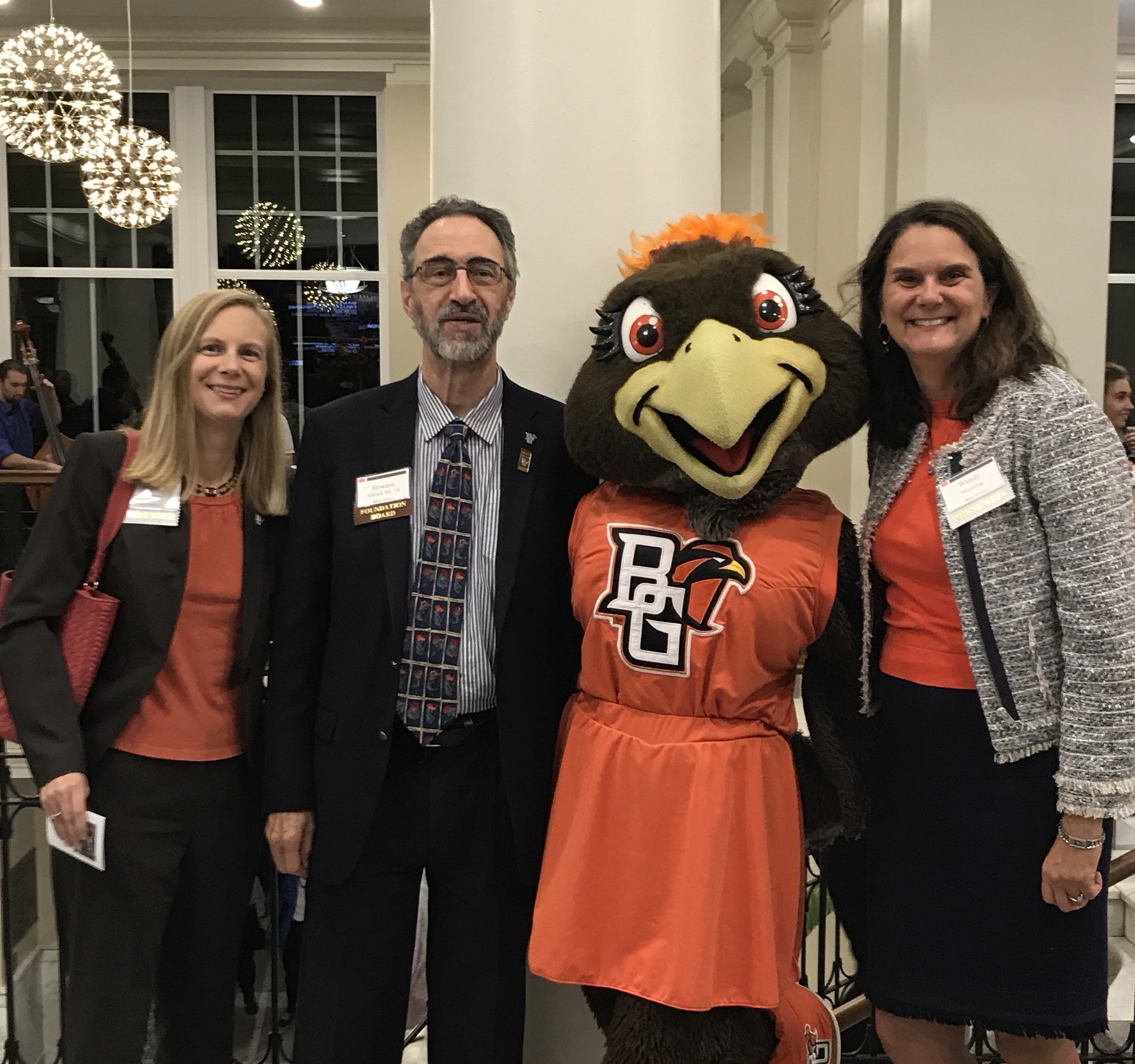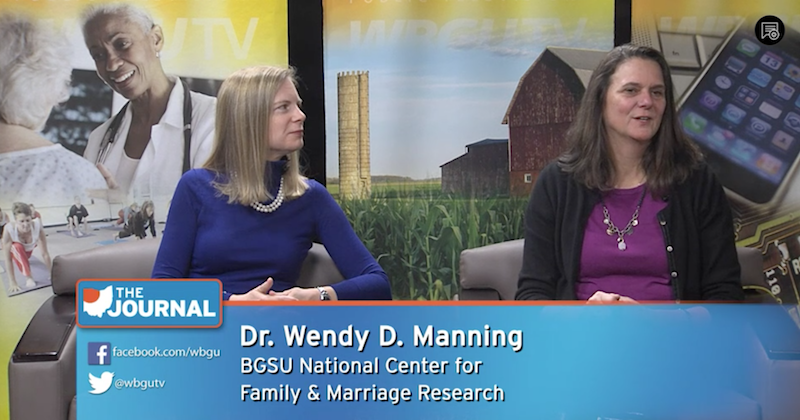NCFMR in the News 2018
NCFMR research topics are wide-ranging and diverse. To further our reach, NCFMR Co-Directors, NCFMR/BGSU Research Affiliates, students, and staff participate in conferences, workshops, and seminars across the country, sharing policy-relevant research on American families with practitioners, fellow researchers, and policy makers. Disseminated as working papers, publications, data resources, and presentations, our research often garners national attention.
Susan Brown discusses marital status and cancer treatment with the Washington Post
After years of study, debate about the "premarital cohabitation effect" continues
Wendy Manning and Jessica Cohen's 2012 research in the Journal of Marriage and Family concluded cohabiting with a spouse prior to marriage is not related to marital stability, which disputed earlier findings that living together before marriage is associated with greater odds of struggling in marriage. A 2012 report from the National Center for Health Statistics (NCHS) reached the same conclusion. A new study published in the Journal of Marriage and Family claims the premarital cohabitation effect still exists; researchers agree to disagree.
Premarital Cohabitation and the Odds of Divorce: The Latest
Is living together before marriage associated
with risk in marriage or not?
Psychology Today
Millennials taking different approach to marriage

The divorce rate is declining for the Millennial generation while accelerating for the Boomers.
Payne on complications of calculating divorce rate
There are a few reasons why this number is imprecise. The latest CDC marriage and divorce stats are based on data reported by just 44 states and Washington, D.C. What’s more, some states report marriage counts but not divorce counts and vice versa, says Krista K. Payne, Ph.D., a data analyst at the NCFMR at BGSU. California, for example, isn’t included in the CDC’s crude divorce rate. Data collection isn’t uniform either, so states can do it however they want. Historically, states are better at collecting data on marriages; they’re more much more lax regarding divorces.
Brown notes characteristics of young married couples today signal decline in divorce rates in coming years
While the divorce rate has doubled for people aged 55 to 64, and tripled for Americans 65 and older, Gen X and Millennials experience fewer divorces.
Susan Brown and I-Fen Lin discuss the gray divorce trend with U.S. News & World Report
The sudden jump in older age divorce rates is a phenomenon commonly called gray divorce, which was uncovered by Bowling Green State University researchers Susan Brown and I-Fen Lin in a landmark 2012 study. Brown says the data were the same as recently as 2016. "Older adults are at the forefront of family change," explains Brown, a distinguished professor and chair of the sociology department. "Most divorces among older adults are happening in the 50- to 64-year-old age range."
Wendy Manning recognized with Endowed Distinguished Professorship

Wendy Manning has been appointed to the Dr. Howard E. and Penny Daum Aldrich Distinguished Professorship in Sociology. This Professorship is designed to recognize and retain exceptional faculty, and we are tremendously fortunate to have her as our co-director and colleague at BGSU. The Distinguished Professorship was gifted to the institution by Howard and Penny Aldrich, both of whom are graduates of BGSU. Howard Aldrich is Kenan Distinguished Professor of Sociology at the University of North Carolina-Chapel Hill.
Nearly half of middle-aged and older couples with children are in stepfamilies
Drawing on national data from the 2012 Health and Retirement Study (HRS), Professor I-Fen Lin and Distinguished Research Professor Susan L. Brown establish a portrait of stepfamilies in later life. Here, they discuss the two main paths to stepfamily living for elders.
Boomers and older Americans are divorcing late in life
About one in four people who divorced in 2010 was age 50 or older, vs. one in 10 in 1990. Boomers also portend a rising divorce rate out to the year 2030, according to study authors Susan L. Brown and I-Fen Lin, of the National Center for Family & Marriage Research at Bowling Green.
Krista Payne discusses grandparenthood research with BGSU's The Morning Show
Larry Weiss of BGSU's The Morning Show sits down with Dr. Krista Payne to discuss grandparents and grandfamilies.
Additional resources on grandparenthood can be found in our data resources.

Seven percent of marriages hit the half-century mark
Huijing Wu, graduate research assistant, and Susan Brown, Distinguished Research Professor, examined shares of older, married individuals who have reached their golden anniversary.
Will the #MeToo movement make dating harder?
CFDR Associate Director Karen Guzzo discusses the #MeToo movement with the Toledo Blade.
“Is it going to making dating harder?” Ms. Guzzo said. “It should make dating better.”
Karen Guzzo addresses decline in birth rate

Is America's Record Low Birth Rate a Cause for Concern?
US Birth Rate Hits All-Time Low: What's Behind the Decline?
What's Discouraging Millennials From Starting a Family?
Consciously uncoupled: A quarter of American parents are unmarried as more people choose cohabitation over vows
Wendy Manning discusses cohabitation with the Daily Mail.
"Cohabitation is here to stay, and I think it's a legitimate family form that we need to recognize," Manning said. "I don't see a retreat in cohabitation anytime soon."
"Cohabitation is here to stay."
--Wendy Manning, Bowling Green State University
Susan Brown and Huijing Wu examine LAT (Living Apart Together) Relationships
Huijing Wu, graduate research assistant, presented an analysis of nearly 7,700 Wisconsin adults aged 50 and older at #PAA2018. Married couples accounted for 71.5% of that group, single people accounted for 20.5%, and people who were “partnered but unmarried” accounted for 8%. Of the partnered group, 39% were in LAT relationships, according to a more focused definition of this arrangement, compared with 31% who were dating (a less committed, shorter-term relationship) and 30% who were cohabiting.
“It’s really remarkable that older adults are in the vanguard of family change,” said NCFMR Co-Director Susan Brown.
Karen Guzzo Discusses Advantages of Childbearing in Mid-Life
Having an older mom can be better for kids, Karen Guzzo, CFDR associate director and a sociologist at Bowling Green State University, told me, as these kids are more likely to be born into stable, long-term relationships to parents who are more financially secure than they were in their 20s and 30s. --the Atlantic
Brown And Lin Receive President’s Award For Collaborative Research And Creative Work Award
Drs. Susan Brown and I-Fen Lin, professors in the Department of Sociology, have been working with two graduate students on a National Institutes of Health-funded research project on gray divorce and well-being. Using a collaborative approach, Anna Hammersmith, PhD candidate, and Matthew Wright, recent PhD graduate, have been integrated into all stages of the research process.
In recognition of this effort, they received a President’s Award for Collaborative Research and Creative Work at the Faculty Excellence Awards April 9. The award recognizes innovative research and creative work conducted by faculty members in collaboration with graduate students.
Number of American Millennials living with parents or grandparents has more than doubled
Lydia Anderson's research found in 1980, just 9% of 25- to 34-year-olds were living with their parents or grandparents. In 2015, 22% were doing so.
Wendy Manning discusses #CohabitationBoom with the Atlantic

After conducting a series of interviews with cohabiting parents, Manning found that many were just as committed to their families as their married peers. “They’re making a lifelong commitment to their child by living together and raising their children in a two-parent family,” said Manning. “They don’t feel that marriage is important—it’s more important that they are there, every day, taking care of their kids.”
Manning notes how Census question is presented on survey could influence participation
Either way, Manning says the publicity the citizenship question will receive could deter some from filling out the form in the first place.
“It’s very late in the game to be adding questions,” she says. “It’s going to affect allocation of resources to communities that need them.”
A Census Citizenship Question Wouldn't Just Impact Blue States
Governing: The States and Localities

Are marriages that persist for five or more decades unusual?
Using data from the 2014 ACS, Huijing Wu, graduate research assistant, and Susan Brown, Distinguished Research Professor, found only 7% of current marriages have a duration of 50 or more years.
Hemez speaks with News-Press about marriage, divorce
Graduate Research Assistant Paul Hemez examines marriage and divorce data and finds there have been about 2.2 million marriages per year and 1.1 million divorces.
"...it doesn't mean that half of the U.S. Population has experienced a divorce. Instead, it means that for every two new marriages in a particular year, one from a previous year will end in divorce."
Is the institution of marriage constantly evolving?
Business Insider cites Kasey Eickmeyer's GenX/Millennial research.
Eickmeyer examined NSFG data finding 64% of millennials and Gen X-ers believe that living together before marriage may help prevent divorce.
Nine percent of grandparents in the U.S. live with their grandchildren
Using Survey of Income and Program Participation (SIPP), 2014 data, Huijing Wu, graduate research assistant, examines grandparenthood in the U.S.
Karen Guzzo and Bart Stykes' research finds about 26% of marriages include stepchildren
Using NSFG data, Karen Guzzo, associate professor of sociology and associate director of the CFDR, and Bart Stykes, former graduate research assistant, found "63% of women who remarry come into blended families, with half of those involving stepchildren who live with the new couple..."
Nationally, the divorce rate has declined, according to statistics compiled by the NCFMR
Wendy Manning tells Portland Press Herald...
Some experts and researchers think one reason for lower divorce rates is that people are getting married older, and hopefully, wiser. That’s coupled with the fact that there is less pressure today to get married for the express purpose of having a family. And people certainly don’t feel like they have to get married to have sex, as people might have a couple of generations ago.

Generation Z defined by diversity

Dr. Krista Payne tells The Blade that Generation Z is the "most racially diverse generation we have ever seen." Fourteen percent ages 12-22 have foreign-born parents, compared to 7% among Millennials at same age.

WBGUTV The Journal's Steve Kendall discusses the past decade of research with the BGSU National Center for Family & Marriage Research's Drs. Susan Brown and Wendy Manning.
Watch Now!

“There’s a lot of trends that are ongoing that make this an especially exciting time to be studying the American family,” Wendy Manning, a distinguished research professor, said. Susan Brown added that the center prides itself on measuring the increasingly complex social context in which people live, “That’s one of our contributions.”
Manning dishes about the dating scene with The Toledo Blade
"...marriage rates are rising in Lucas County, while in other parts of the country — rates are stagnant or falling. People who start off single here might have more luck finding a long-term mate than they would elsewhere."


Updated: 12/11/2024 02:11PM


